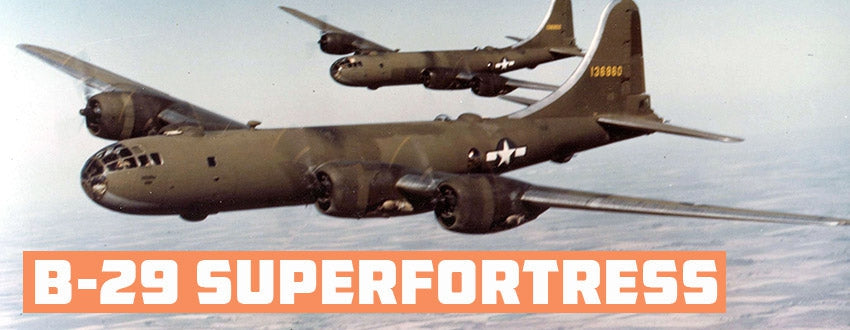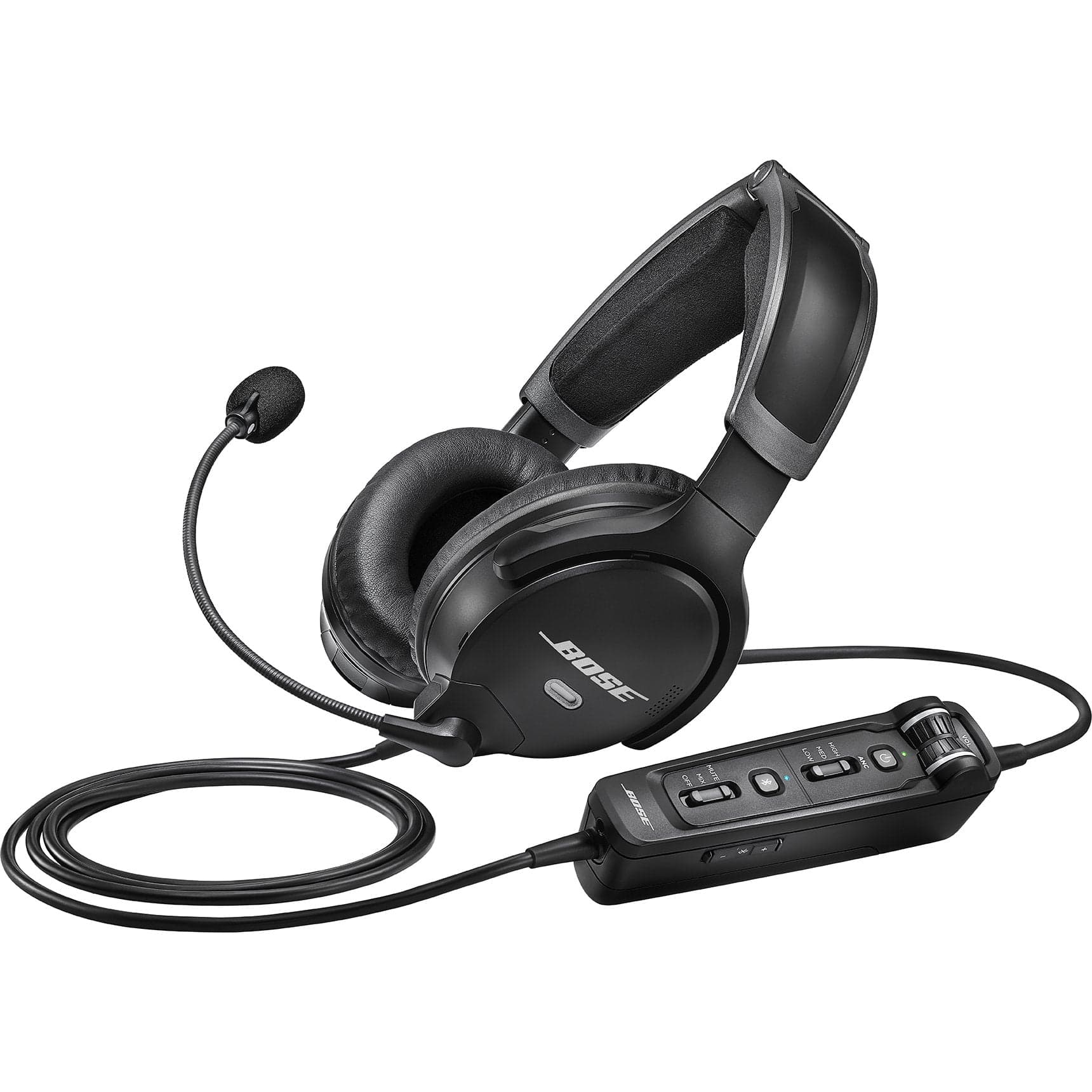The aircraft that was chosen to run two of the most pivotal missions of the Second World War flew higher, faster, and further while carrying a heavier payload than any other bomber.
These planes were designed to be just what the U.S. military needed to succeed in the Pacific Theater, particularly the United States Air Forces.
Meet the WWII game changer—the B-29 Bomber, a Boeing aircraft, otherwise known as the B-29 Superfortress.
What was the development and design process for the B-29 bomber?
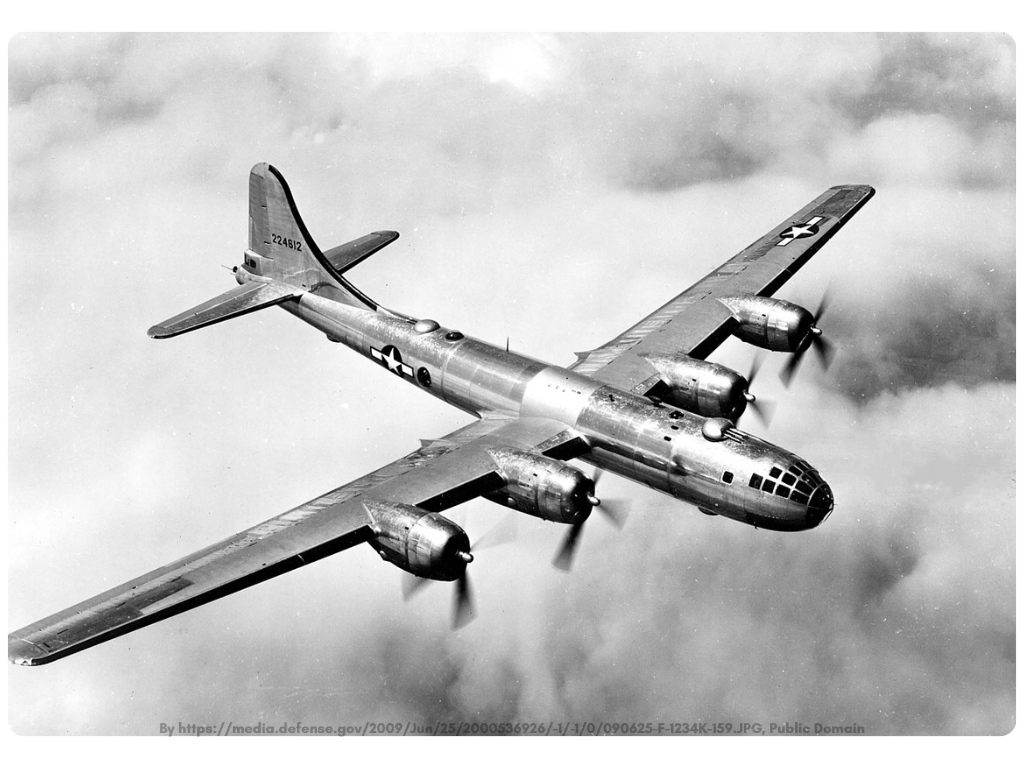 The development of the B-29 began in the late 1930s with the concept for a very long-range heavy bomber which could be based in the U.S. and still reach any enemy country around the world.
The development of the B-29 began in the late 1930s with the concept for a very long-range heavy bomber which could be based in the U.S. and still reach any enemy country around the world.
Faced with the specter of World War II, the U.S. Army Air Corps (AAC) assessed their current go-to bomber, the B-17 Flying Fortress and found its capabilities inadequate for carrying sufficient payload to the Pacific Theater.
The AAC put together the following list of specifications for their ideal bomber:
- B-29 bomb load: 20,000
- Speed capability: 400 mph
- Long Range: 5,000+ mile
- High altitude capability
- Pressurized crew cabin
Boeing, Consolidated Aircraft, Lockheed, and Douglas all drew up initial designs for such an aircraft. While Douglas and Lockheed ultimately moved on to other projects, Boeing and Consolidated continued work.
In the fall of 1940, the War Department commissioned protypes from Boeing with Consolidated Aviation’s program being pursued as a backup in case anything went wrong with the Boeing built project. Four factories began work and on September 21, 1942 the first B-29 prototype made a successful maiden flight.
The Army Air Corps accepted delivery of the first production B-29 aircraft on May 30, 1944. The long-anticipated bomber was put directly into service and ran its first combat mission a mere fifteen days after delivery, earning it the fitting name “Rush Order.”
The speed with which the B-29 moved from prototypes into production meant that designers were still making design changes to fix problems after aircraft were already being produced.
The completed aircraft would then need to undergo special modification and alterations to meet the new specifications. This added time and money to the project.
With the weight of all its armaments, the finished B-29 did not quite meet the AAC’s 400 mph target max speed, however it met the other specifications and included some very unique and highly advanced features.
What was unique about the B-29 bomber?
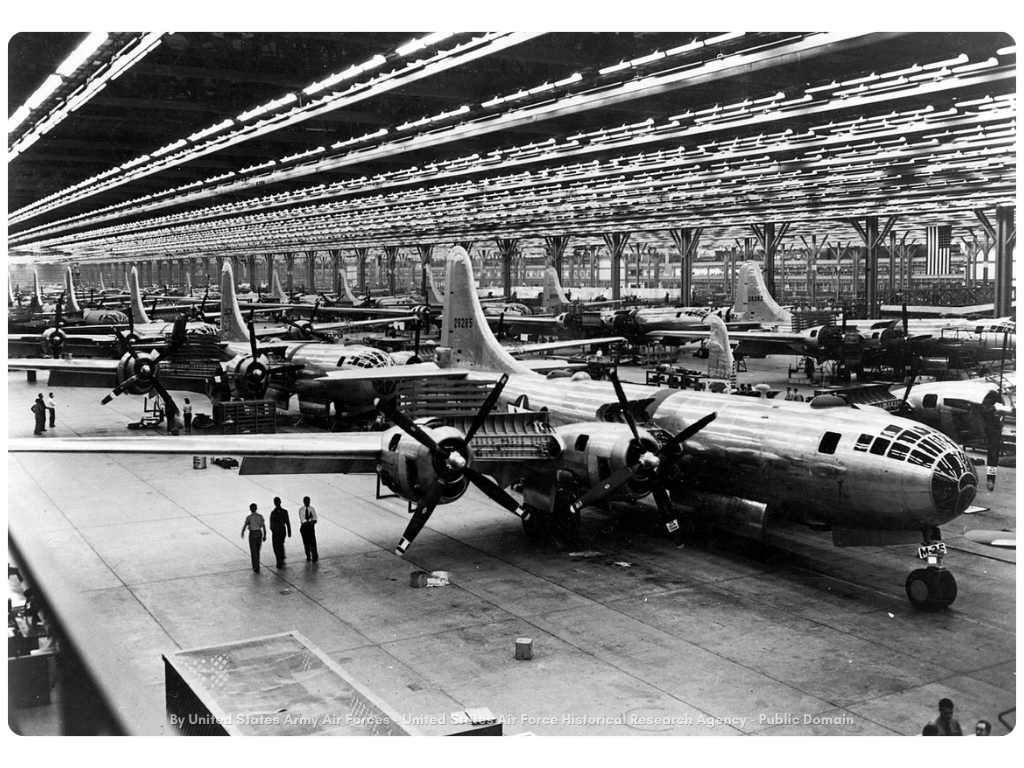
- High bomb load capacity
The B-29 Superfortress was designed as an upgrade to its predecessor – the B-17 Flying Fortress. The B-17 could carry a 5,000-pound bomb load. The new bomber B-29 could carry up to 20,000 pounds.
- Fully pressurized crew compartments
Despite the high altitudes that the B-29 was designed to fly at, all crew members – even the gunners – could remain in pressurized crew cabins while carrying out their duties.
This was a radical improvement over previous bombers which placed gunners in non-pressurized turret balls or openings in the fuselage.
The B-29 design incorporated three pressurized crew compartments throughout the bomber along with a pressurized tunnel that the crew could use to crawl between the fore and aft compartments while bypassing the unpressurized bomb bays.
- Remote control gun turrets
One of the revolutionary pieces of advanced technology which was incorporated into the B-29 was a sighting system for each of the 5 remote controlled turrets with their two .50 caliber mounted Browning M2 machine guns.
The fire control officer operated the “fire control” system from a sighting station outfitted with a computer. The computer automatically adjusted for variables like airspeed, temperature, gravity, humidity and calculated the lead distance needed for the gun turrets to hit the target.
- Fighter escorts not required
One of the drawbacks of the B-17 was that for all its armaments, it still needed fighter escorts to protect it. The weapons platform of the B-29 was designed so that it was fully capable of defending itself.
- Why was the B-29 bomber called the Superfortress?
The B-29’s Superfortress name is derived from its predecessor, the B-17 Flying Fortress. According to the History Channel, the Flying Fortress was so named by a Seattle reporter.
Upon touring the Boeing plant where the B-17s were being made, the reporter was so impressed by their defensive firepower that he exclaimed, “It’s a flying fortress.”
The name stuck, and as the subsequent B-29 bomber was even more fortified than the B-17, it came to be known as the Superfortress.
How were the B-29 bombers used by the military?
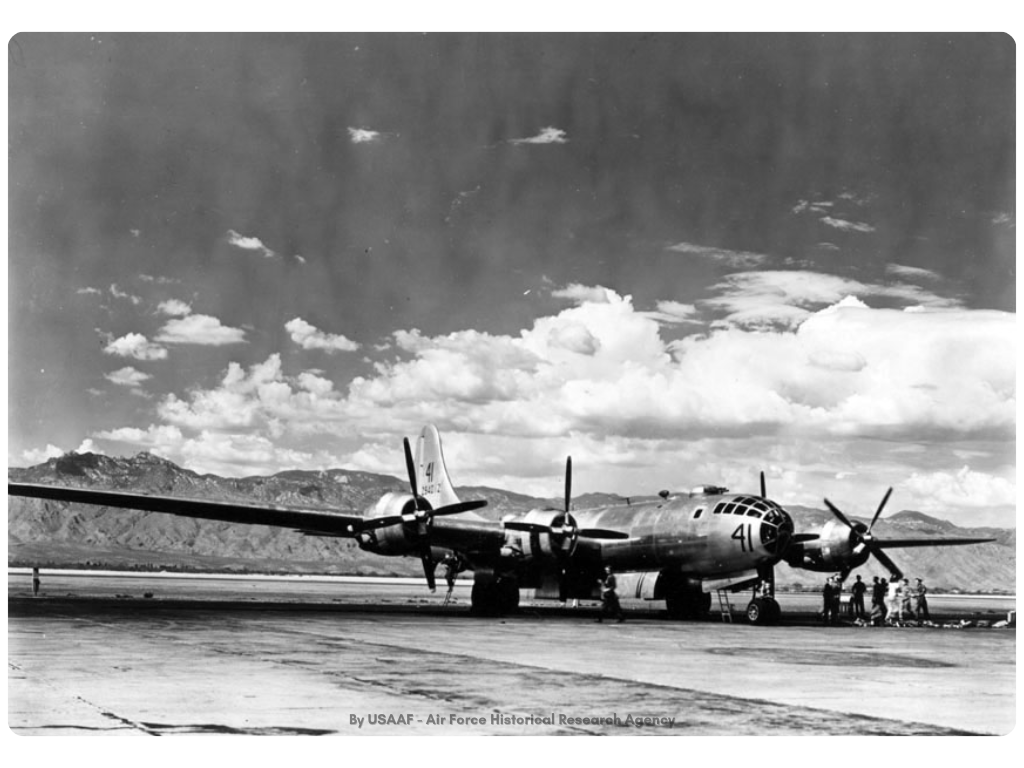 During the summer of 1943, General Hap Arnold submitted a proposal to use the newly developed B-29 to conduct bombing runs on Japanese cities from bases in China.
During the summer of 1943, General Hap Arnold submitted a proposal to use the newly developed B-29 to conduct bombing runs on Japanese cities from bases in China.
The proposal was subsequently approved, and the plan was carried out in June of 1944 under the codename Operation Matterhorn. Although Operation Matterhorn was unsuccessful, it marked the B-29’s entry into U.S. military combat use.
By October of 1944, B-29 were arriving in the Mariana Islands to continue the high-altitude bombing campaign on Japan.
The B-29s were designed for high-altitude, however the missions were plagued with problems and were not producing successful results, so in January 1945 the concept of operations was shifted to low-altitude (5,000 foot) nighttime runs using incendiary napalm bombs. This tactic proved much more effective.
In August of 1944, two B-29 bombers would carry out the missions that this aircraft is most remembered for – the atomic bombings of Hiroshima and Nagasaki.
Following WWII, the B-29 fleet continued to be used by the military through the Korean War. The final Superfortress was retired by the Air Force in 1960.
What were some of the problems with the B-29 bombers?
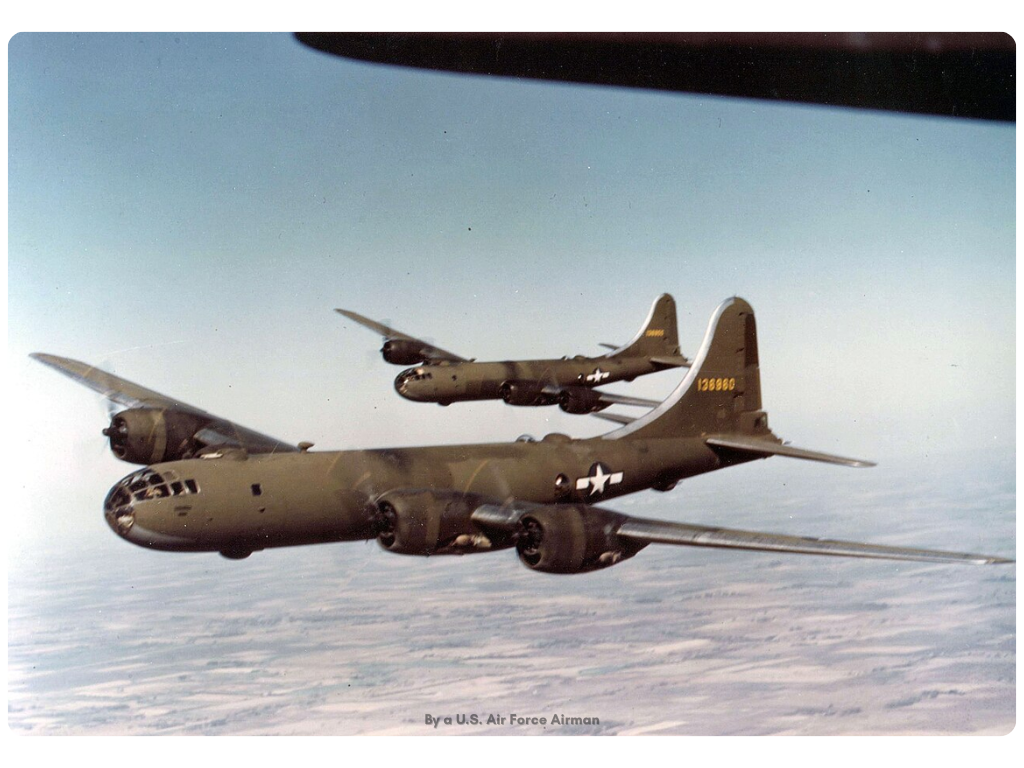 Thanks to a combination of the complexity of the design and hurried development due to production timeline pressures, Boeing’s B-29s had some performance challenges.
Thanks to a combination of the complexity of the design and hurried development due to production timeline pressures, Boeing’s B-29s had some performance challenges.
- Overheating engines
The first protype performed well in testing, but it was unarmed. Unfortunately, the second prototype, armed with the full armament load-out not so fortunate.
Its’ first flight was aborted after it experienced a severe engine fire due to overheating from the heavy load. On a subsequent flight, the second prototype suffered another engine fire which caused it to crash.
The engine problem was finally solved in the post-war Superfortress models by swapping out the original Wright R-3350 Duplex Cyclone for a Pratt & Whitney R-4360 “Wasp Major.”
- Difficult handling
Pilots said that when fully loaded, the B-29 could be difficult to handle. The 20,000 pounds of bombs on board also added additional risk during takeoff.
- Overshooting or undershooting target
Engineers and pilots were initially baffled as to why the B-29 struggled with accuracy on bombing runs. They noticed that the aircraft would sometimes overshoot and sometimes undershoot the target, but no one knew why.
A meteorologist finally correctly realized that because the B-29 was flying at such a high altitude, it was impacted by the jet stream. The bomber’s flight direction relative to the jet stream needed to be considered and the effects compensated for to correct the overshoot/undershoot issue.
Was there more than one variant of the B-29 bomber?
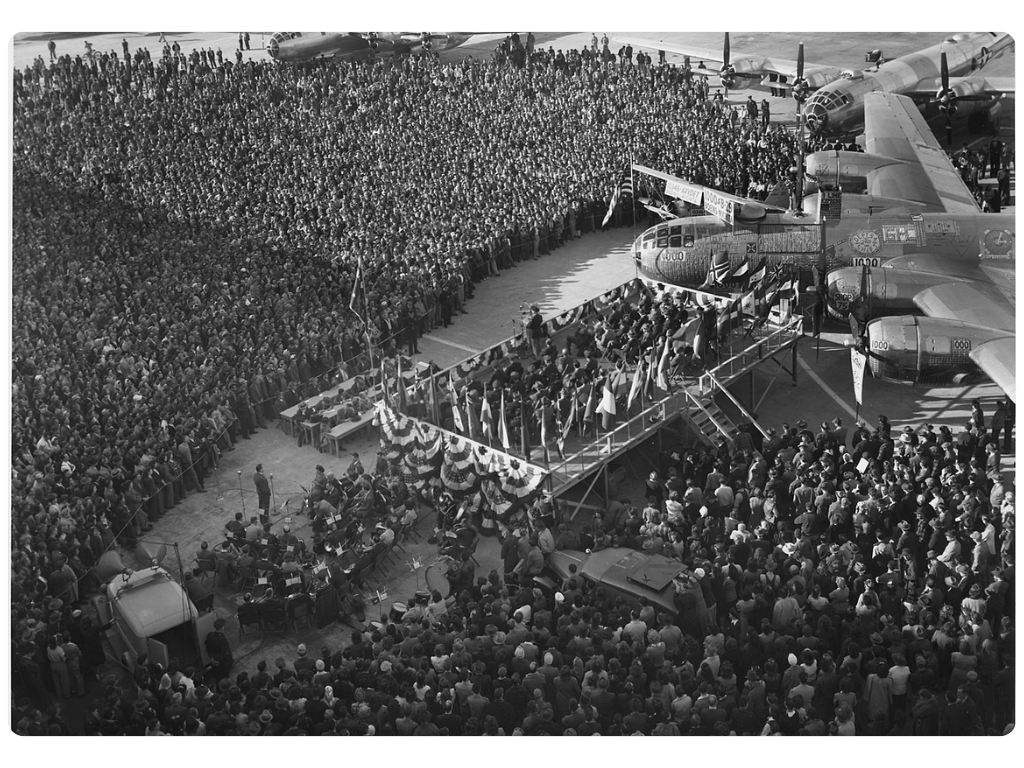 During the war, there were three versions of the Superfortress, and afterwards, the B-29 was adapted to fill other functions like in-flight refueling, reconnaissance, weather reconnaissance, anti-submarine patrol, and rescue.
During the war, there were three versions of the Superfortress, and afterwards, the B-29 was adapted to fill other functions like in-flight refueling, reconnaissance, weather reconnaissance, anti-submarine patrol, and rescue.
B29-Superfortress.com keeps a record of the B-29 variants along with examples of some of their nose art.
As WWII was ending, several B-29s had to make emergency landings and one crashed over the Soviet Union. Rather than returning the aircraft, the Soviets decided to keep and analyze the B-29s so that they could reverse-engineer them.
The resulting aircraft was named the Tupolev Tu-4. These bombers were used by the Soviet Union for decades, and some were given to China as well.
The Soviets discontinued use of the Tupolev Tu-4 by 1960, however China continued using their reverse-engineered B-29s until 1980.
What is the most famous B-29 bomber?
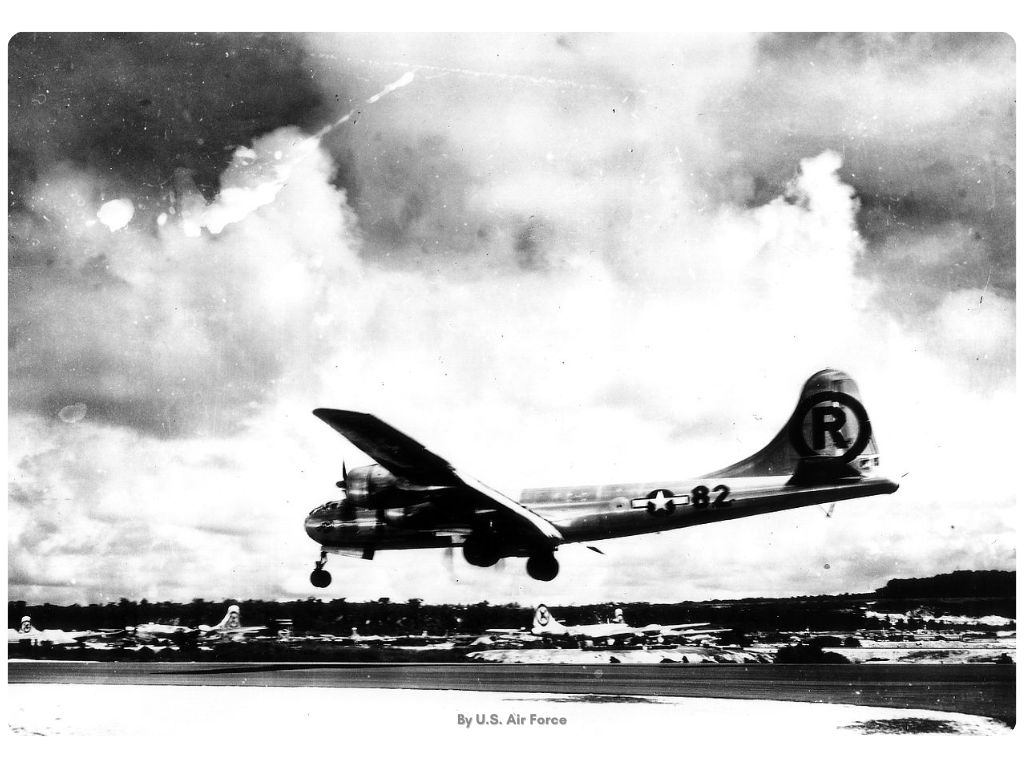 Undoubtedly one of the most renowned B-29 bombers and credited with a significant impact on history is the iconic Silverplate series Enola Gay. The the bomb bay of the aircraft was modified to accommodate carrying atomic bombs.
Undoubtedly one of the most renowned B-29 bombers and credited with a significant impact on history is the iconic Silverplate series Enola Gay. The the bomb bay of the aircraft was modified to accommodate carrying atomic bombs.
In a pivotal moment on August 6th, 1945, under the command of Colonel Paul Tibbetts, this aircraft served as the launch point for the devastating atomic bomb known as "Little Boy," forever altering the city of Hiroshima, Japan.
Three days later on August 9th, another Superfortress bomber – the Bockscar – piloted by Major Charles Sweeney dropped a second atomic bomb christened “Fat Man” over Nagasaki, Japan.
Historians credit these two missions with bringing about a swift end to the war. Emperor Hirohito announced Japan’s surrender on August 15th – just nine days after the first bombing.
- Where is the Enola Gay today?
If you want to see the Enola Gay in person it is on display in the National Air and Space Museum’s Steven F. Udvar-Hazy Center located in Virginia.
Are any B-29 bombers still flying today?
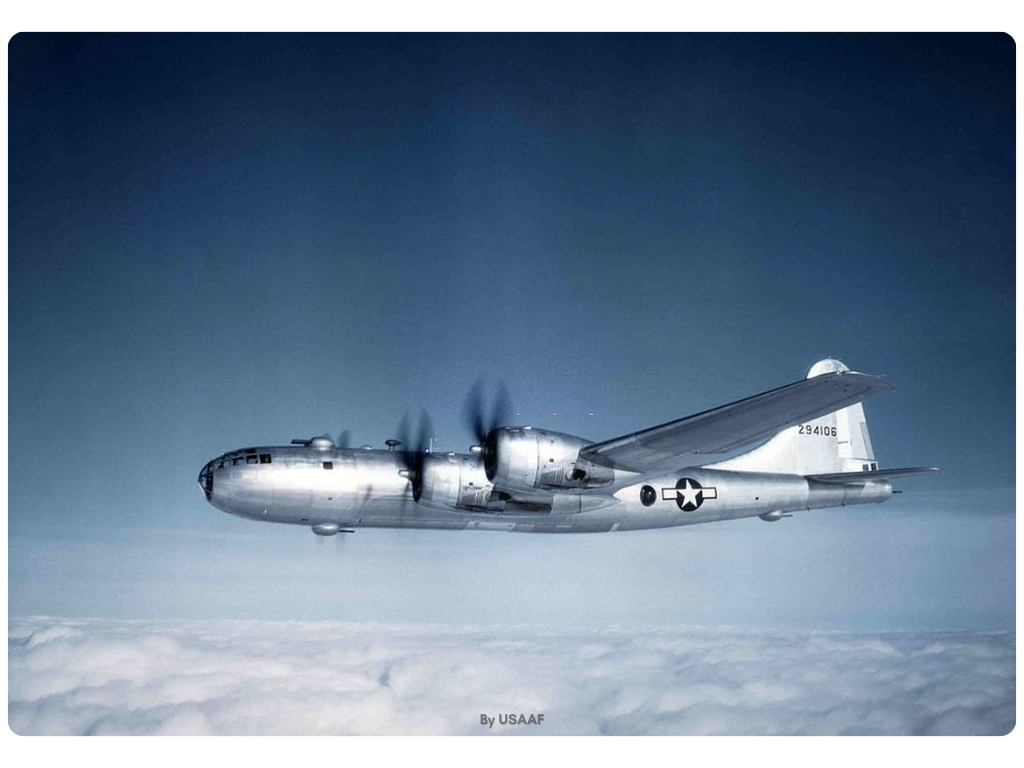 Of the 3,970 B-29’s built between 1942 and 1946, 26 have survived intact. Many of these live on as static displays in museums, at airfields, and on Air Force bases. Two lucky B-29s are still airworthy after having been adopted by crews who lovingly restored and care for them.
Of the 3,970 B-29’s built between 1942 and 1946, 26 have survived intact. Many of these live on as static displays in museums, at airfields, and on Air Force bases. Two lucky B-29s are still airworthy after having been adopted by crews who lovingly restored and care for them.
Serial number 44-62070 is known as Fifi, and she is based out of Addison, Texas. Fifi spent time as an administrative aircraft and later as a ballistic missile target before being adopted by the Commemorative Air Force.
This non-profit Texas organization preserves historical aircraft and displays them at airshows around the country. Fifi’s restoration was completed in 1974, and other than being grounded for a few years from 2006 to 2010, she has continued to make her rounds of major aviation events including Oshkosh AirVenture.
Fifi’s caretakers enjoy teaching the public about her, as evidenced by their full walkaround video tour. If you want to see what it is like to be onboard a B-29 while in flight, watch FlightChops’ real-time video of Fifi doing a flyover at Oshkosh AirVenture.
For decades, Fifi was the lone airworthy B-29 left flying the skies, but in 2016, serial number 44-69972 now known as Doc joined her. Following military service, Doc returned home to Wichita, Kansas and in 1998 was restored at the same Boeing plant where it was originally built.
After restoration, Doc was moved to the Kansas Aviation Museum and was placed on display until 2013 when a non-profit organization dubbed Doc’s Friends purchased the aircraft and set about the process of obtaining an airworthiness certificate from the Federal Aviation Administration.
Doc’s certificate was granted in the summer of 2016, and some of Fifi’s flight crew members took Doc back to the skies for the first time in sixty years. Doc now tours the county as well, keeping a unique piece of aviation history alive.
Both Fifi and Doc offer aircraft tours and flight experiences at their many stops, giving aviation fans the opportunity for a truly memorable and rare experience. You can also add a Fifi model plane or Doc model plane to your desktop collection.
There would have been one more operational B-29 with an interesting history if disaster had not struck twice for B-29 serial number 45-21768 known as Kee Bird. In the winter of 1947 Kee Bird was on a Cold War reconnaissance mission near the North Pole when a bad storm and fuel shortage forced the pilots to make a crash landing on a frozen lake of northern Greenland.
The crew survived and was rescued, but Kee Bird was abandoned and remained untouched on the lake until 1994 when a private aircraft restoration team attempted to make the plane operational again so it could be flown home.
Weather closed in and the team had to abort the attempt, returning the following year to try again. This time, the repairs were made, a bulldozer created an ice runway, and Kee Bird was ready for takeoff. As she began to taxi, disaster struck again.
Gasoline began to leak from the auxiliary power unit’s fuel tank and fire broke out. The flames soon engulfed the fuselage and although the crew make it out, Kee Bird was all but destroyed. The wreckage still sits partially submerged in the frozen lake.
What are the best documentaries and movies about the B-29 bomber?
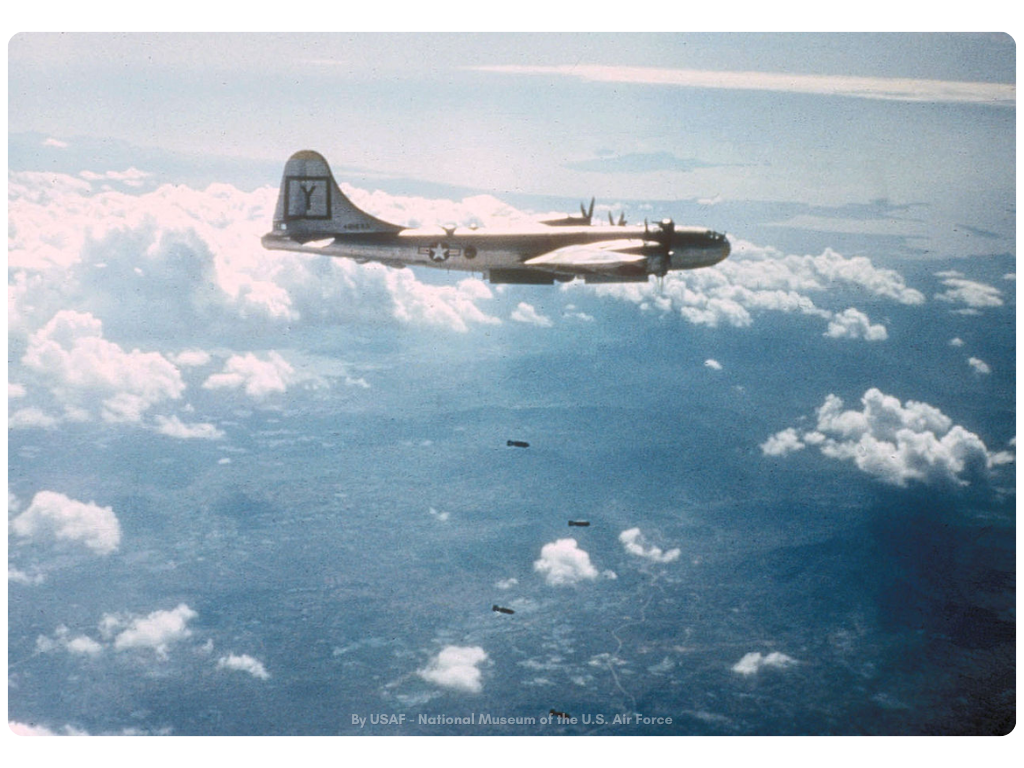 Multiple films have been made about the B-29 bombers. Two of the most well-known are The Wild Blue Yonder (1951) and Above and Beyond (1952).
Multiple films have been made about the B-29 bombers. Two of the most well-known are The Wild Blue Yonder (1951) and Above and Beyond (1952).
The Wild Blue Yonder is a World War II war drama set against the backdrop of military officers learning to fly the new B-29. The film follows the officers through training and on to China and Guam where they prepare to run bombing missions against Japan.
Above and Beyond is a biographical action drama centered on Colonel Paul Tibbets as he leads the team testing the B-29 and ultimately planning and flying the mission to drop the atomic bomb on Hiroshima.
This film confronts the toll the project took on Tibbets as well as his wife whom he was not able to confide in during this time due to national security concerns.
Does the view from the Superfortress cockpit look familiar to you? If you have watched Star Wars, it should. The Millennium Falcon’s cockpit is clearly inspired by the B-29.
For a general documentary on the B-29, check out Famous Bombers of WWII Season 1, Episode 6. This show starts at the beginning and takes you through the design and build process, as well as the challenges and triumphs of the B-29 program.
Finally, check out NOVA’s documentary entitled B-29 Frozen in Time which follows the restoration and subsequent heartbreaking demise of Kee Bird.
Specifications of the B-29 bomber
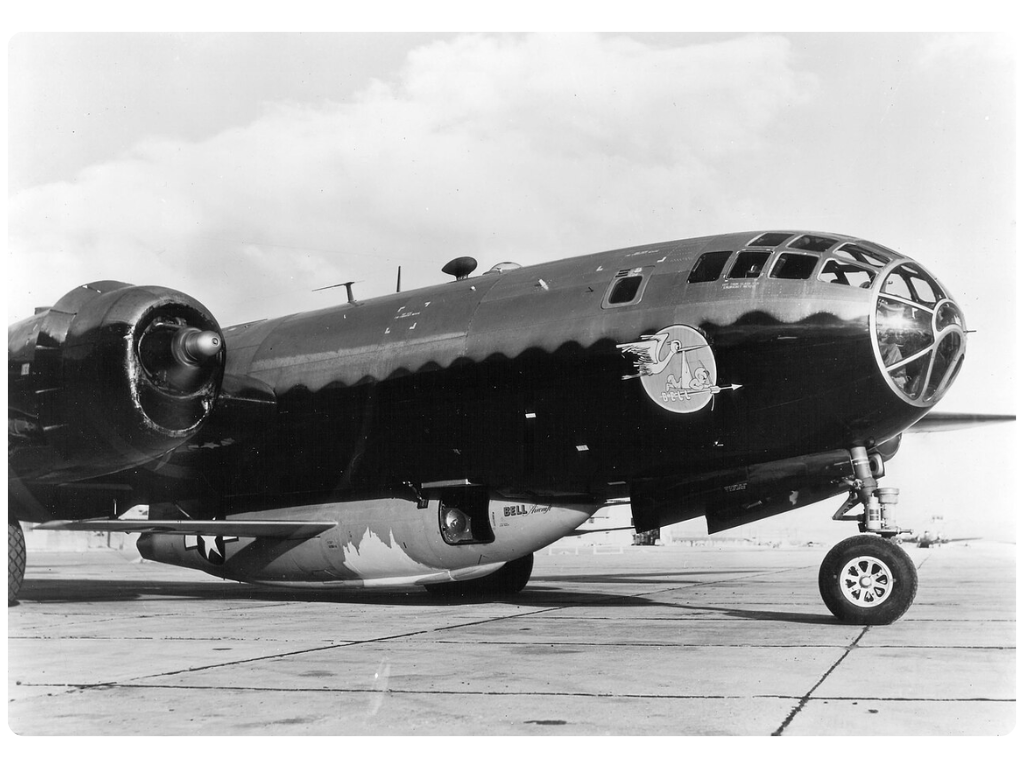
- Top speed: 365 mph
- Cruising speed: 220 mph
- Range: 5,830 mi.
- Service ceiling: 31,850 ft.
- Gross weight: 105,000 lbs.
- Engines: Four 2,200 horsepower Wright R-3350-23 Duplex-Cyclone engines
- Length: 99 ft.
- Height: 28 ft.
- Wingspan: 141 ft. 3 in.
- Crew complement: 11
- Armament: Twelve .50-caliber machine guns; One 20mm tail cannon; 20,000-pound bomb load
Takeaways
The B-29 Superfortress holds an important place in history due to its role in ending World War II. This heavy bomber was built to a very specific set of goals and parameters.
It represented the technological advancements of military aviation with its fully pressurized crew cabin and state-of-the-art remote-control weapons sighting system.
Despite the need for numerous on-the-fly design changes, the B-29 got the job done and ultimately proved to be a World War II game changer.
Check out our Enola Gay Boeing B-29 Superfortress Bomber Limited Edition Large Mahogany Model - available exclusively at Pilot Mall.
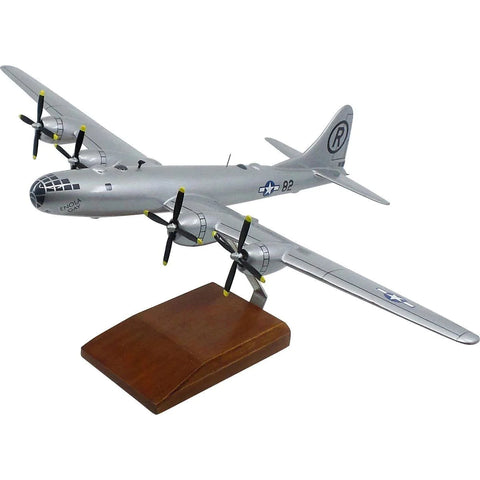
|
Boeing B-29 Superfortress Limited Edition Large Mahogany ModelThis exquisite Enola Gay Boeing Built B-29 Superfortress Bomber Mahogany Model is handcrafted by our master craftsmen from the finest Mahogany Wood. Attention is given to every detail, resulting in unsurpassed quality. Models come complete with a detachable wood display stand.. |
Want to learn more about aviation history?
Our guides provide everything you need to know.
-
22 Famous Female Pilots That Left a Mark on Aviation History
-
7 Mid-Air Collisions That Changed Aviation History (w/ Pictures)
Did you find this article helpful?
Do you think we missed anything important? Let us know in the comments below!

